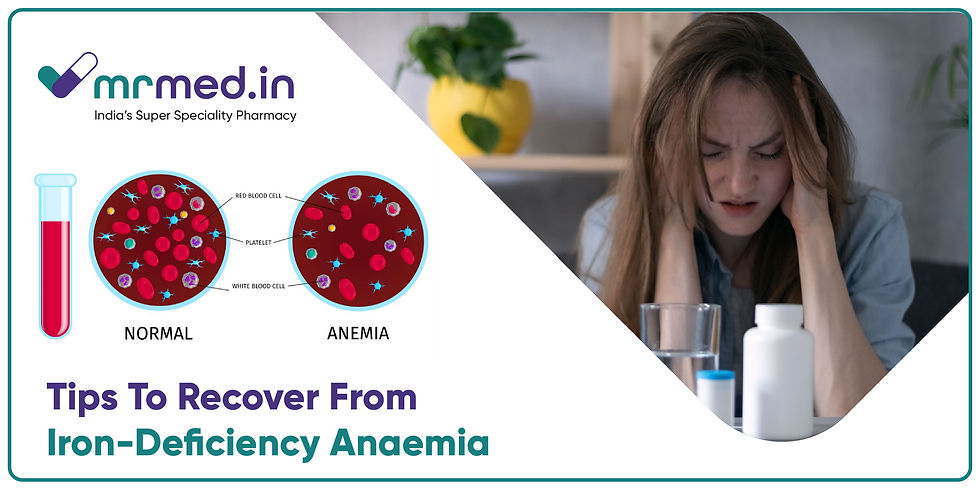Iron-Deficiency Anemia Recovery: Simple Steps to Feel Better
- Healthcare Tips

- Feb 8
- 4 min read

Do you often feel exhausted even after a full night’s sleep? Are you experiencing dizziness, headaches, or pale skin? If so, you may have iron-deficiency anaemia, a condition that occurs when your body lacks enough iron to produce haemoglobin. Without it, your body struggles to function properly, leading to fatigue and other health problems.
The good news is that iron deficiency anaemia is manageable and treatable. Let's dive into everything you need to know about iron deficiency and how to recover effectively.
What are the signs of iron deficiency?
Many people overlook the early symptoms of iron deficiency, often attributing them to stress or a busy lifestyle. However, untreated iron deficiency can lead to severe complications. Some common signs of iron deficiency include:
Extreme fatigue and weakness
Pale or yellowish skin
Shortness of breath, even with mild activity
Dizziness or lightheadedness
Cold hands and feet
Frequent headaches
Brittle nails and hair loss
If you notice any of these symptoms, it’s important to get your iron levels checked. Ignoring them can worsen your condition, leading to severe anaemia that affects your overall health.
What causes iron deficiency?
There are several reasons why a person might develop iron deficiency.Some key factors that contribute to iron deficiency include:
1. Poor Diet
Your body gets iron from the food you consume. If your diet lacks iron-rich foods, you may develop a deficiency over time. This is especially common in people who follow vegetarian or vegan diets without proper iron sources.
2. Blood Loss
Losing blood means losing iron. This is why women who experience heavy menstrual periods are at a higher risk of iron deficiency. Other causes of blood loss may occur like gastrointestinal bleeding from ulcers, surgery, or frequent blood donation.
3. Increased Iron Needs
Certain life stages increase your body’s iron demands. For example, pregnant women need more iron to support the baby’s growth. Similarly, growing children and teenagers require extra iron for proper development.
4. Poor Iron Absorption
Some medical conditions can prevent your body from absorbing iron properly. These include:
Celiac disease
Crohn’s disease
Gastric bypass surgery
If you have any of these conditions, you may need additional iron supplements to maintain healthy levels.
How can I improve my iron levels naturally?
Recovering from anaemia starts with making the right lifestyle and dietary choices. Here’s how you can boost your iron levels naturally:
1. Eat More Iron-Rich Foods
Here are some iron-rich foods to add to your diet:
Lean red meat (beef, lamb)
Poultry (chicken, turkey)
Seafood (oysters, clams, tuna)
Leafy greens (spinach, kale)
Legumes (lentils, chickpeas, beans)
Fortified cereals and whole grains
To enhance absorption, pair these foods with sources of vitamin C, like oranges, strawberries, and bell peppers.
2. Cook with Cast Iron Cookware
Using cast iron pans can naturally increase the iron content in your food, especially when cooking acidic foods like tomatoes. This is an easy way to boost your iron intake without additional supplements.
3. Avoid Iron Blockers
Some foods and drinks interfere with iron absorption. Limit your intake of:
❌ Tea and coffee (contain tannins that reduce iron absorption)
❌ Dairy products (high calcium can compete with iron)
❌ Processed foods high in preservatives
Try to consume these foods separately from your iron-rich meals for better absorption.
4. Take Iron Supplements (If Needed)
If a healthcare provider detects low iron levels, they might suggest iron supplements. However, these should be taken only under medical guidance, as too much iron can be harmful. Common side effects may include constipation, nausea, and stomach discomfort.
How long does it take to recover from iron deficiency?
Recovery from iron deficiency varies based on how severe the deficiency is. If you’re making dietary changes and taking supplements, you may start feeling better within a few weeks. However, it can take several months for your iron levels to return to normal.
To track your progress, your doctor may recommend regular blood tests to measure haemoglobin and ferritin levels.
Can iron deficiency affect women's health?
Yes! Women’s health is closely linked to iron levels. Due to menstruation, pregnancy, and postpartum recovery, women are at a elevated risk of iron deficiency. If left untreated, decreased iron levels can lead to:
Increased fatigue and reduced productivity
Weakened immune system
Pregnancy-related issues, including early delivery and reduced birth weight
When should you see a doctor?
If you experience recurring symptoms despite making lifestyle tweaks, it’s time to seek medical advice. You may be asked to conduct tests to determine the severity of your anaemia and suggest appropriate treatments.
In some cases, iron infusions or injections may be necessary. Eligard Injection, used for specific medical treatments, can sometimes impact blood health, making regular monitoring essential.
Additionally, medications like Leuprolide Acetate can affect iron levels in some patients. Always discuss your medical history with your doctor for the best treatment plan.
Final Thoughts
Recovering from iron deficiency is possible with the right approach. Simple changes like eating iron-rich foods, avoiding absorption blockers, and taking supplements (if needed) can significantly improve your energy levels and overall health.
Don't ignore the signs of iron deficiency—early intervention is key to preventing complications. If you suspect low iron levels, consult a healthcare professional and take proactive steps to boost your well-being.
By prioritising your iron intake, you’ll not only feel better but also enhance your body’s overall function. Start today, and take charge of your health!
Comments